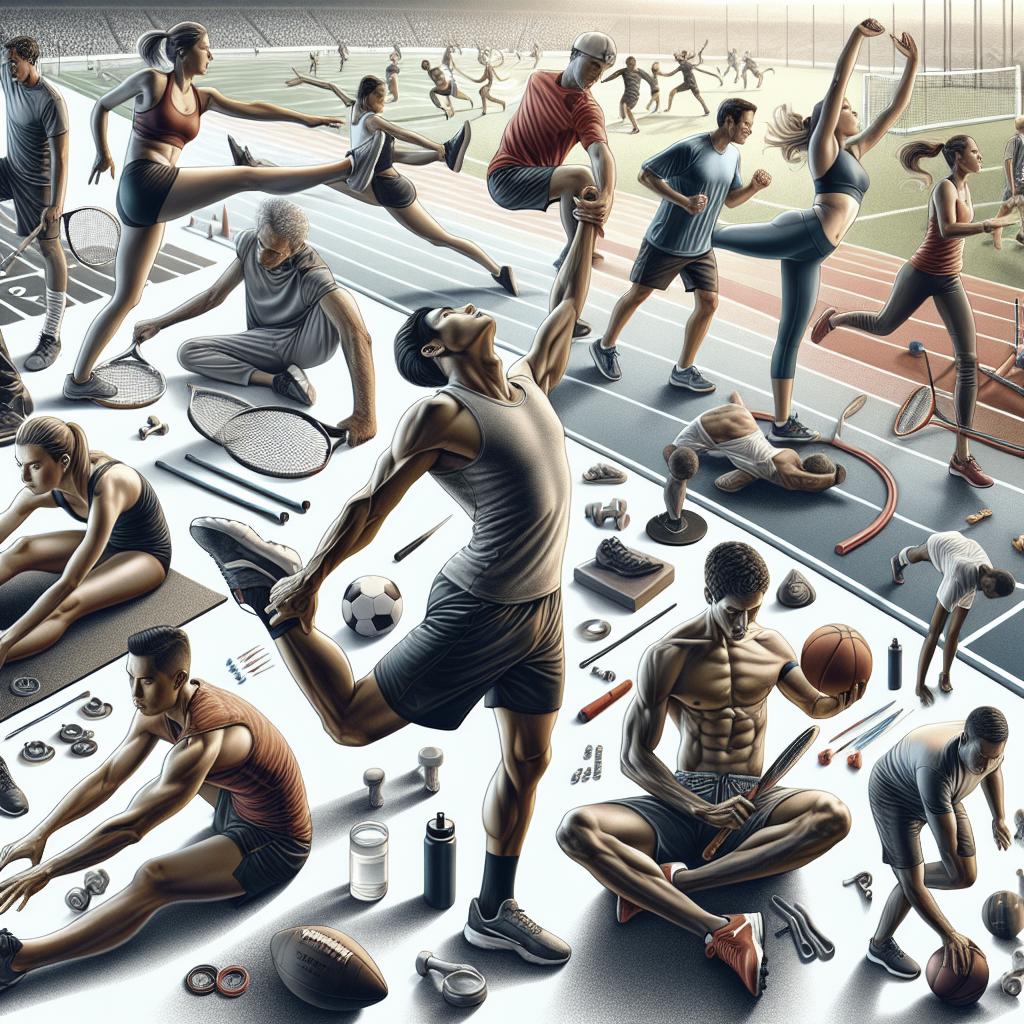<>
For athletes, a proper warm-up is an essential component of preparing for any physical activity. A well-designed warm-up routine not only enhances performance but also significantly reduces the risk of injury. This blog post delves into the importance of dynamic warm-ups, how to perform them, their myriad benefits, and examples of essential exercises. By incorporating these practices into your routine, you can ensure your body is primed and ready for peak performance.
Dynamic Warm-Up: What Is It?
Dynamic warm-ups involve a series of movements performed in a controlled manner to increase muscle temperature, enhance muscle elasticity, and prepare the body for the demands of the upcoming exercise. Unlike static stretching, which holds a stretch for an extended period, dynamic warm-ups keep the body moving to simulate the activities that will follow.
These exercises range from fundamental movements like walking lunges to more sport-specific actions like high knees or carioca. The goal is to progressively elevate your heart rate and get your blood flowing to all muscle groups, making them more pliable and less susceptible to strains and injuries.
How To Do A Dynamic Warm-Up?
To execute a dynamic warm-up, start with general movements to gently elevate the heart rate and increase body temperature. Gradually incorporate more specific exercises that align with the main activity you will be performing. For instance, if you’re gearing up for a sprint session, include drills like high knees and butt kicks.
It’s important to:
- Start slowly and build intensity gradually.
- Include exercises that mimic the range of motion of the forthcoming activity.
- Ensure each movement is performed with proper technique to prevent injury and maximize effectiveness.
Benefits Of Dynamic Warm-Up
Increase Blood Flow to Muscle Tissues
Dynamic warm-ups enhance blood circulation, ensuring oxygen and nutrients are efficiently delivered to muscle tissues. This boost in blood flow makes muscles more pliable and prepares them to perform optimally during high-demand activities.
Improve Heart Rate
Gradually elevating the heart rate through dynamic movements prepares the cardiovascular system for the intense physical exertion of a sporting event or workout session. This gradual increase helps to avoid sudden stress on the heart.
Stimulate Nervous System
Dynamic exercises effectively stimulate the nervous system, improving coordination, balance, and proprioception. This heightened neural activation ensures that muscle groups work synergistically, enhancing overall athletic performance.
Improve Mobility And Core Temperature
By incorporating a range of dynamic movements, athletes improve joint mobility and core temperature. This effect facilitates a greater range of motion and reduces the stiffness that can lead to strains and injuries.
Lessened Injury Risk
One of the main benefits of a dynamic warm-up is reducing injury risk. Muscles, tendons, and ligaments are better prepared to handle the stresses of physical activity, thereby diminishing the likelihood of strains, sprains, and more severe injuries.
Essential Dynamic Warm-Up For Athletes
Walkouts
Walkouts, also known as inchworms, focus on stretching and warming up the hamstrings while engaging the core. Begin in a standing position, bend at the waist, and walk your hands forward until you reach a plank position. Walk your feet toward your hands and repeat.
Groomers
Groomers, or leg swings, expand hip mobility and flexibility. Stand on one leg and swing the opposite leg forward and backward or side to side. This exercise effectively opens up the hips and prepares the legs for explosive movements.
Crawls
Bear crawls and other variations activate the entire body, emphasizing coordination and core strength. Begin on all fours and move by simultaneously lifting one hand and the opposite foot. Continue alternating sides to move forward.
Lunge Variations
Lunges are versatile and can be modified to target different muscle groups. Walking lunges, reverse lunges, and lateral lunges help to stretch and strengthen the legs and glutes while enhancing balance and mobility.
Cossack Slides/Squats
Cossack squats are excellent for enhancing hip and groin flexibility. Stand with your feet wide apart, shift your weight to one side, and lower into a deep squat while keeping the opposite leg straight. Alternate sides to ensure balanced mobility.
High Knees
High knees activate the hip flexors, improve running form, and increase heart rate. Jog in place, driving your knees up toward your chest with each step while swinging your arms rhythmically.
Jumps
Jumps, including vertical jumps and jumping jacks, are effective for increasing explosive power and activating fast-twitch muscle fibers. These exercises serve as a final push to ensure the body is ready for high-intensity activity.
Sample Dynamic Warm-Up for General Sports and Fitness
A typical dynamic warm-up should last around 10-15 minutes, include a blend of all the previously discussed exercises, and gradually escalate in intensity. Here’s a sample routine:
- Jogging or light running: 2-3 minutes to raise heart rate
- High knees: 1 minute
- Walking lunges: 1 minute
- Leg swings: 30 seconds each leg
- Inchworms: 1 minute
- Bear crawls: 1 minute
- Cossack squats: 1 minute
- Jumping jacks: 1 minute
Ensure to maintain control and focus on proper form throughout each exercise.
Wrapping Up
Dynamic warm-ups play a crucial role in an athlete’s training regimen, offering numerous benefits ranging from improved performance to reduced injury risk. Incorporating these dynamic movements into your regular routine can optimize your physical readiness and contribute to long-term athletic success. Make these exercises a non-negotiable part of your pre-activity preparation.
Featured Posts
1. The Importance of Recovery in Training
2. Nutrition Tips for Peak Athletic Performance
Latest Posts
1. How to Build a Personalized Fitness Plan
2. Exploring the Newest Trends in Sports Technology
Free VBT Guide
Download our comprehensive guide on Velocity-Based Training to maximize your workout efficiency and track progress like never before. Stay ahead with cutting-edge techniques designed for optimal athletic development.
| Section | Content |
|---|---|
| Dynamic Warm-Up: What Is It? | Overview of dynamic warm-ups and their purpose in preparing the body for physical activity. |
| How To Do A Dynamic Warm-Up? | Steps and tips for performing a dynamic warm-up, including starting gradually, mimicking upcoming activities, and focusing on proper technique. |
| Benefits Of Dynamic Warm-Up | List and explanation of the benefits, such as increased blood flow, improved heart rate, stimulated nervous system, enhanced mobility, and reduced injury risk. |
| Essential Dynamic Warm-Up For Athletes | Detailed descriptions of key exercises like walkouts, groomers, crawls, lunge variations, Cossack slides/squats, high knees, and jumps. |
| Sample Dynamic Warm-Up for General Sports and Fitness | A 10-15 minute sample routine combining different dynamic exercises to prepare the body for general sports and fitness activities. |
| Featured Posts | Links to related articles on recovery and nutrition for athletes. |
| Latest Posts | Links to the newest blog entries about customized fitness plans and sports technology trends. |
| Free VBT Guide | Details about a free guide on Velocity-Based Training for optimizing workout efficiency. |


